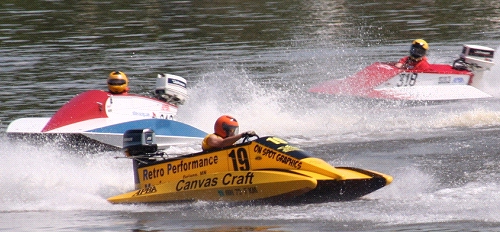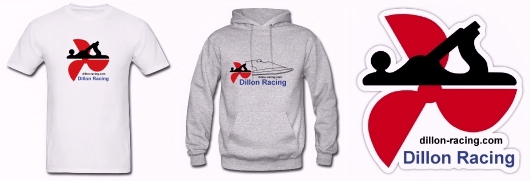
| Build Your Own Raceboat |
GT Pro Outboard Powerboat Racing |

GT Pro is a Sportsman class created by the Twin City Powerboat Association (TCPBA) and is raced in TCPBA events.
Power: 30/35hp 2-cylinder Johnson/Evinrude
Boat: Tunnel or V-bottom, 10' min.
Min. Age: 10 years old (see rules, below)
GT Pro rules
Dillon Pro Tunnel -- Dillon Mini VeeTCPBA conducts races in Minnesota (and sometimes surrounding states) featuring most of the national OPC classes, plus two local classes: Mini GT and GT Pro. Top speeds at TCPBA events range from 40 mph to 120 mph.
GT Pro is open to tunnel, v-bottom and modified vee boats, built of any material, production-built, home-built or custom-made, powered by 35 hp, 31.8 cubic inch, two cylinder OMC motors with hydraulic trim and stainless steel propellers. This is serious mini-boat racing, and a natural progression from Mini GT.
Need boatbuilding HELP!? : Frequently Asked Questions
Buy Plans Now or Continue Shopping Local powerboat racing is a family-oriented motorsport where friends get together to share a passion. Racers are always ready to share advice, tools, equipment or muscle, and help their fellow racers get the most out of their rigs. We save the competition for the races themselves.

If you are interested in becoming a GT Pro (or Mini GT) racer, or want to know more about powerboat racing in general, please feel free to contact me with your questions, or go to the TCPBA website.
If you are not prepared to build your own boat, there are Boats For Sale.
Hydraulic Trim:
Trim is allowed in GT Pro racing, and is a nice addition to any high performance boat. The following resources will help you set up a trim system for your boat.
:: Notes on a adding trim for your OMC GT Pro motor.
:: Building a bracket for the other end of the trim cylinder -- part of my jack plate plans.
:: See also the "Setting Up" page for the Mini Vee and Pro Vee v-bottom racing boat.

Dillon Racing Stuff: T-shirts, sweatshirts, and more....
Note: Store items come from a secondary supplier and can
only be purchased through their shopping cart
GT PRO Rules
New For 2013: Blue text represents Rules changes, approved at the 2013 APBA National Meeting.
A. Driver's Minimum Age 10 (formerly 12)New drivers under 12-years-old will be required to take a minimum of 3 driving school sessions (to be conducted on race weekends) that include at least 5 laps on a race course by themselves. Driving school is allowed for drivers 9 years of age although they will not be able to compete until age 10. After completing 3 driving schools, driver will be on rookie status until released by a referee.B. Motors (NOTE: see also OPC rules #24 and #25 regarding replacement parts and modifications.)
1. Any 25 horsepower (small bore carburetor), two cylinder, 31.8 cid., thru-hub Johnson or Evinrude;
2. Any 30 or 35 horsepower (large bore carburetor), two cylinder, 31.8 cid. Johnson or Evinrude is allowed.
3. Unlimited part swapping with parts origninal to the 31.8 cid. OMC powerhead is allowed.
4. Engines must be stock, -- as manufactured (no blueprinting) -- with the following exceptions
a. Rpm limiters and oil injection systems may be removed.
b. Electric start may be added
c. Solid or pinned motor mounts are allowed.
d. Tiller arms may be removed
e. Air silencers may be removed
f. Skeg wear bar may be removed
g. Under-flywheel ignition may be converted to powerpack ignition using OEM or aftermarket parts/kits.
h. Neutral start switch may be removed
i. Cylinders may be bored .30 over and fitted with OEM oversize pistons.
j. Reeds of any material, OEM or aftermarket, are allowed.
5. 30/35 hp only: Power trim, manual-trim or spoilers, adjustable while the boat is underway is allowed. Up to 24 volt starting system allowed.
6. Transom adapters for raising, lowering or extending the engine will be allowed, but must be fixed while underway
7. Two 1" diameter holes that can be readily plugged (for testing) may be drilled in the lower unit above the cavitation plate.
8. Cosmetic appearance of engine may be changed.
9. Engines must be securely bolted to the boat with a minimum of two bolts
C. Boats: Minimum 10'0" long and 48" wide; Minimum Weights: 30/35 hp -- 650 Lbs.; 25 hp -- 525 Lbs.
1. Boats of any material, homebuilt, custom-built or production, are allowed
2. Boats may be v-bottom, modified vee or tunnel (no hydroplanes). Four inch minimum tunnel depth at transom.
3. Drivers must be sitting in a seat at all times, using a foot throttle and steering wheel.
4. Junction of seat and seat back may not be more than 36" rearward of midships.
5. Boats must have a minimum of 3 cu. ft. of flotation foam.
6. Boats will be required to start off plane.
D. Propellers -- Any propeller, prop nut, washer and thrust washer.
Need boatbuilding HELP!? : Frequently Asked Questions
Dillon Pro Tunnel
Payment Options
More Info/VideoDillon Mini Tunnel
Payment Options
More Info/VideoDillon Pro Vee
Payment Options
More Info/VideoDillon Mini Vee
Payment Options
More Info/Video
* * * * * *
Email sent to my GT Pro list, 12/5/07
GT Pro racers and interested parties,
There has been some confusion and/or ignorance about the differences between the various 31.8 cubic inch OMC motors built from 1976 thru 2005. I may have told some of you that the 35 hp engines had different porting specs from the 20 - 30 hp motors, but it's beginning to appear that I was wrong.
Jeff Talcott has been pouring over parts lists and picking the brains of some people in the know, trying to figure out how these 32 cubic inch OMCs differ. Here's what he's come up with so far:
It would appear that the blocks for all these motors, 20, 25, 30 and 35 hp, are fundamentally the same, with the same port timing and specs. There are some differences in port shape: most are round, drilled ports, while others are milled, oval ports. The oval ports seem most common on electric-start 30 hp models from the early- to mid-90s (and maybe other years), plus some older (pre-1985) 35 hp models.
As far as we know there is no performance difference between the oval and round port motors. But if the oval port motors prove to have an advantage, we may want to consider banning them from the class as some point in the future in order to maintain a level playing field.
More investigating is going on. But if this turns out to be the case, then any of these 32 cube OMC motors will be usable for GT Pro. You will want to re-fit a 20 hp model with the 30/35 hp intake manifold and carburetor; the 25 may only need the larger carb, but the intake can be changed as well. (The 25hp intake and the 30/35 intake differ in interior volume only; the 20hp intake has a very small front opening, which acts like a restrictor plate. Evidence suggests that there is no difference at all between a 30 and a 35, other than port shape in some cases.)
It has also been suggested that reed stops may differ with horsepower, but the parts lists I've seen don't reflect that -- they show the same reeds and stops for the entire hp range.
Generally speaking, we are talking about the 31.8 cubic inch, 2-cylinder, 2-stroke, single-carb, thru-hub exhaust motors from the following years:
1976 -- 1994 35 hp
1984 -- 2005 30 hp
1985 -- 2005 25 hp
1985 -- 1999 20 hpThe 25 hp models seem to have been made every year in their range. Other horsepowers were not made in all the years in their range. For some years you won't find both Johnson and Evinrude motors of a particular hp.
Seventies vintage 35 hp models differ in some ways with later ones, particularly in the lower unit. Part swapping between the 1970s and later motors will not always work.
(OMC also made 3-cylinder 25 and 35 hp motors starting in 1995. The 25 triple is only 30 cubes and is heavier than the twin, but the 35 triple is 34 cubes, which exceeds the GT Pro limit (32 cubes). Since it may not be easy to distinquish between these motors, I would hope we could amend the rules to exclude the 3-cylinder motors from the class. Limiting ourselves to single-carb motors would also accomplish the task, as these 3-cylinder motors have three carbs.)
Conclusion: Jeff and I will continue to look into this matter. Hopefully, we'll establish that all these blocks are essentially the same, that there are no special high performers lurking out there, and that we can simply buy whatever we find and then upgrade intake and carb as needed. So before you bend over backwards to get that "real" 35hp OMC, you might want to wait. Or if you get a good deal on a 20 - 30 motor you might want to grab it. (There is a very good used parts supplier a few miles from my house, so it should not be too hard to come up with these parts. Let me know what you need.)
And if you have anything to add to this subject, please do.
Bob Dillon,
GT Pro class captainp.s. Some relevent links:
Online parts lists for all the OMC motors back to the early '70s, at least. They will ask for your email address at the entry page, but they I don't think they've emailed me more than once -- and I've given them my address many times.

HOME
BUILD A RACEBOAT
• Tunnelboats
• V-bottoms
• Jackplate Plans
• Cockpit Plans
• Seat Plans
• My Customer's Projects
• Bob's Projects
• Start YOUR Project Today!
CONTACT
HELP!
About Bob
Send a Link to a Friend

• POWERBOAT RACING
• Mini GT
• GT Pro
• Sport C
• Boats For Sale
• VIDEO
Sitemap

